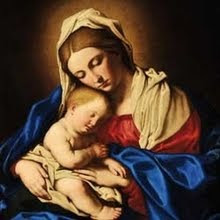
From June 25 to August 28, 2011 35 paintings from the fifteenth to the eighteenth century from the collection Altomani-Ciaron tell the story of two neighboring territories that have flourished over the centuries art gone far beyond regional boundaries. In the varied and often contradictory world that goes under the name of Italian antiques are also active experts of international standing, who are responsible to track, restore, study and possibly return to their original works of art that the time has dispersed and confined in 'oblivion.
A move is a feeling that, by the enchantment of beauty, is sometimes reflected in an ethics of memory. From this same feeling comes The Lands of the painting between the Marche and Romagna, a choice anthology of ancient paintings, which gathers 35 works from the collection Altomani-Ciaron, held in Cesena (FC), the Municipal Gallery of Art Palace of the Reduced by 25 June to August 28, 2011.
From Madonna and Child by the Master of Castrocaro to that of Giovanni Francesco da Rimini, a virgin to a newly discovered by Cagnacci of Sassoferrato, a major modelletto Bargellini by Ludovico Carracci's altarpiece paintings depicting the Resurrection to two recently discovered, one of ' Albani and other Pomarancio, the paintings on display tell the story of two adjacent territories, the Marches and the Romagna, which for many centuries have suffered along with the influences of nearby schools Bolognese, Venetian, Roman, but at the same time allowed also the flowering of artistic personalities who have managed to extend their ideas beyond regional limits. Are also two unpublished Virtues painted by Elizabeth Sirani for Malvasia and two unfinished paintings by Simone Cantarini, to mention just a few of the gems of the collection.
The exhibition, which gathers around 35 paintings covering a period from the fifteenth to the early eighteenth century - with a prevalence of seventeenth-century paintings - is promoted by cultural institutions and services of the Municipality of Cesena and is curated by artist and historian 'Maximum Pulini art. And 'the second appointment reserved for large collections of antiques, a cycle exhibition which opened in 2010 at Cesena with the exhibition "The Study of Swaps", born from the original intention of creating a series of exhibitions and catalogs, dedicated to those that can be considered real hidden museums.
The Lands of the painting between the Marche and Romagna is a collection of sacred and profane (there are landscapes, portraits, religious subjects, etc. ..) that is configured as a rich anthology of memories and memories of places and people, stories individual and group that for more than three centuries have enriched this part of the peninsular.
The exhibition is accompanied by a catalog published by Artexplora, which contains an essay on the topic of loss and recovery of works of art and the important role played by some antique lighting. And 'thanks to these figures, in fact, working for decades in the world of antiques with the minutiae of a careful scholar, who was now possible to retrieve much of an artistic heritage that, following the Napoleonic suppression of religious orders and confiscation of their property (enacted in 1797), had taken the path of exile and diaspora.
"Rediscovering the work of an artist of the fourteenth century or the eighteenth century, who worked in our area, buy it at auction or in a palace of American English countryside, her education by researchers competent historians, who know how to reconstruct the tracks and maybe find the original location, is a mission of enormous value - underlined the curator of the exhibition, Maximum Pulini - One of the few ways through which continues to be possible to recover the history and development of a country. That this is accompanied by an economic interest, when that work is taken over by a banking institution, a museum or a wealthy private connoisseur, I find it not only legitimate but necessary to reward the work that is to encourage new research, to fund other future discoveries. "
All works reproduced, even those only transited from Pesaro gallery, have a precise reference to the history of the lands of the Marche and Romagna, and each of the paintings comes with a card that reconstructs the events, leaders by the same interpretation critical.
The exhibition and catalog make use of texts and contributions by Annamaria Ambrosini, Ivana Balducci, Alessandro Brogi, Albert Crispo, Davide Gasparotto, Claudio Gardens, Alexander Giovanardi, Alexander Marks, Gabriel Milantoni, Philip Panzavolta, Semenza Julia, Anna and Raffaella Tambini Zama .
We have the best resources for the art of painting. Check it out for yourself. Best the art of painting site, right here.
Tuesday, November 8, 2011
The paintings on display in the Marche and Romagna to the palace of Reduced
Subscribe to:
Post Comments (Atom)
amazing!!!
ReplyDelete